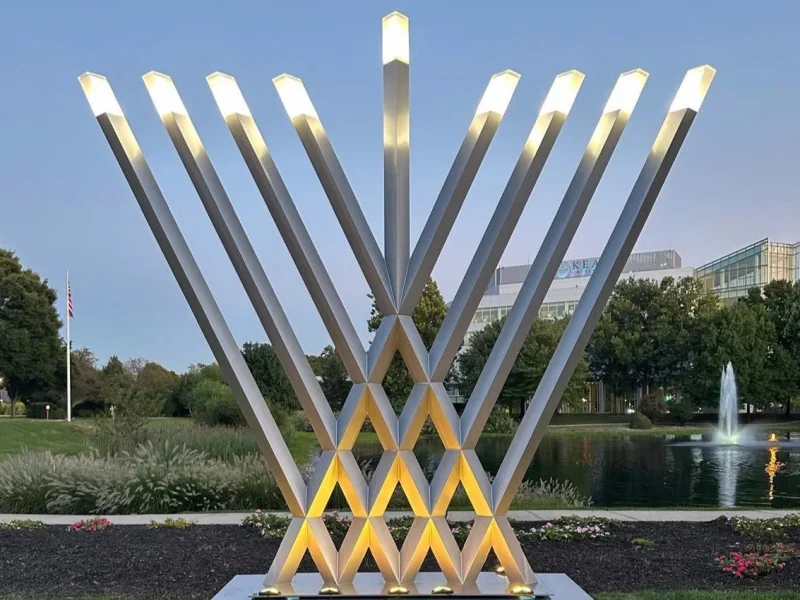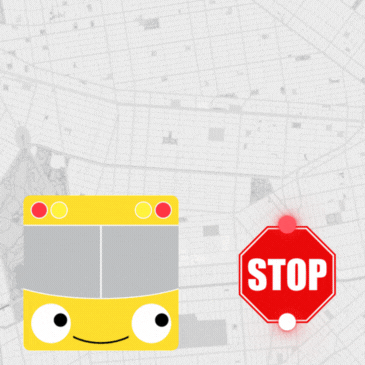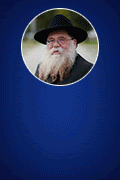
The Pop-Art Rabbi Illuminating Public Spaces, One Menorah at a Time
by Sara Trappler Spielman – chabad.org
An hour before Chanukah was set to begin last year, Rabbi Bentzy Stolik received a call that his Chabad center’s public menorah had been vandalized. Stolik and his wife, Devorah, co-direct Chabad-Lubavitch of Olney, Md., a quiet suburb near Washington, D.C. Yet right there, in full view of a busy main road, someone had toppled over the menorah and bent it out of shape.
The incident, occurring just months after the Oct. 7 terrorist attacks in Israel, was covered widely by the media. Stolik was quick to put the menorah back up while going public with a positive message. But he wasn’t going to rest at restoring things to how they were before. He immediately committed to having a bigger and better menorah the following year.
Enter Yitzchok Moully, an Australian child-of-hippies-turned-rabbi-turned-artist who has made it his life’s mission to expand the artistic within the Chassidic through uniting the two worlds of pop art and Judaism. He is best known for his murals and photo silkscreen works on canvas depicting vibrant, colorful images from Jewish and Chassidic culture—dreidels and Chassidim dancing, kiddush cups and ecstatic prayer.
Now, as the public menorah turns 50, Moully is turning it up a notch with his most ambitious project yet: the Public Art Menorah. Chabad of Olney was among the first recipients of Moully’s new menorah.
It’s particularly fitting that Moully sees his project come to fruition this year, a half-century since the first public menorah was placed on Independence Mall in Philadelphia. Moully grew up reading the books Let There Be Light and its companion volume … And There Was Light, which were released in the mid-1980s by Merkos L’Inyonei Chinuch, the educational arm of the Chabad-Lubavitch movement. The albums highlighted the Chanukah awareness campaign of the Rebbe, Rabbi Menachem M. Schneerson, of righteous memory, and featured photos of Chabad’s public menorahs and Chanukah programs from around the globe.
“I was looking at it and ingesting these menorahs, being inspired by them,” Moully said. “It never occurred to me that I would build one, but I was influenced as a child seeing these menorahs; this book had an impact on me.”
Today, there are more than 15,000 large public menorahs lit annually throughout the world, including in front of the White House, the Eiffel Tower in Paris, the Gateway Arch in St. Louis, and the Brandenburg Gate in Berlin.

‘Something That Was Beautiful and Jewish’
Moully’s project to build beautiful public menorahs is not without precedent. In 1985, Atara Ciechanover—whose husband, Yosef, served for years as chief of Israel’s defense mission in the United States and maintained a close relationship with the Rebbe—passed by Chabad’s giant but utilitarian menorah on Fifth Avenue in Manhattan. A refined woman of high taste, she felt it fell short of the Rebbe’s vision for engaging every single Jew.
Ciechanover took her concerns directly to the Rebbe, bringing with her a sketch for a new menorah designed by her friend, the Israeli sculptor Yaacov Agam.
“She told the Rebbe that she aimed to make a beautiful and dignified menorah,” her husband, Yosef, told Chabad.org in 2016. “The Rebbe agreed with her concern and told her the new one should be built according to the design of the Rambam. He corrected her sketch to show what he meant by it.”
She relayed this to Agam, who got to work on a model. When it was completed, Agam brought it to the Rebbe in New York, and the model sat on the Rebbe’s desk for three days, before he gave his emphatic stamp of approval. The 32-foot-high sculpted bronze menorah—supported by a 28-foot-wide casing—was then built, and upon completion became the world’s largest menorah. It has been erected on the corner of Fifth and 59th ever since, and was kindled every year by Rabbi Shmuel Butman, who passed away in 2024.
“I didn’t only want to create something beautiful; the Romans could also create something beautiful. I wanted to create something that was beautiful and Jewish,” Agam shared with the Rebbe prior to the menorah’s first lighting in 1986. “My goal was to make something beautiful, Jewish and true to its roots. That it should be modern while conveying the ancient.”

Moully sees his work with menorahs along these same lines. For the last seven years, he has been creating large scale Chanukah art displays. The year 2017 was a turning point in his work. It was then that the artist embarked on a journey to broaden and brighten the spectrum of the public menorah concept. What began as large-scale paintings on canvas turned into murals. They then became interactive art experiences, which evolved into 3D interactive touch-sensitive menorahs titled “Living Lights.” The next iteration were iconic custom designs, including a nautical-themed menorah last year at the South Street Seaport in New York City, which is now put on display the entire month of December.
“I realized this is something I need to do every year,” Moully said. “To create a piece of public art for Chanukah, which is in line with the theme of Chanukah of spreading light outside because of pirsumei nisa [the mitzvah to publicize the miracle of Chanukah].”
Moully kept creating menorahs. He didn’t have a five- or 10-year plan, it happened organically. The new limited edition 10 Ft. Public Art Menorahs—Moully produced eight of them, a number that is emblematic of Chanukah—are currently on display at Chabad centers in New York, New Jersey, Maryland and Florida, with one in London.
Each one is designed, engineered and handcrafted by Moully. He cuts the aluminum himself, and then welds and powder-coats it, before topping the menorah with hand-painted, 3D-printed lights. Each menorah features programmed LED lighting at the apex of each arm, while its base is equipped with 10 LED spotlights lighting its form from below.
Moully aims to make beautiful—and usable—pieces of public art accessible to a wider public. “Usually, public menorahs are utilitarian but not unique, not art,” Moully said. “My goal is to make them beautiful and accessible to everyone.”

‘It Has a Big Wow Factor’
When Moully launched the concept last Chanukah, the rendering of the menorah found its way to the Stoliks in Maryland. Planning ahead, they decided to put down a deposit right away, even though they wouldn’t have thought to purchase something as grandiose previously.
“This was a response to our menorah being vandalized, and our answer is to get the best and the most beautiful menorah,” Rabbi Stolik said. “Moully’s menorah fits the bill. It has a beautiful and striking presence, and everyone who sees it is immediately taken by it.”
The Stoliks received the menorah in time for Chanukah, unveiling and inaugurating it on Thursday, Dec. 26—the second night of Chanukah. It was dedicated by community member Steve Dekelbaum, in honor of his parents, Max and Anita Dekelbaum, and will be a permanent fixture installed at Chabad after the event.
Olney’s Chanukah celebration was also attended by freed hostage Aviva Siegel, who shared some words with the community. Siegel’s husband, Keith Siegel—a dual American and Israeli citizen—remains in captivity in Gaza, after being kidnapped by Palestinian terrorists on Oct. 7.
Chabad’s public menorahs and Chanukah displays have over the last half-century become a staple of Jewish cultural and American public life, forever altering the practice and perception of the festival. But Moully knows the work has not yet been completed.
“I’m committed to spreading light outside with menorahs,” Moully says. “Like Moshiach told the Baal Shem Tov, he’ll only come ‘When your wellsprings spread outwards.’ I’m taking it literally to mean that the menorah is outside as public art; it’s a way of bringing these ideas of Torah and Chassidus outside into the world—literally.”














Norah Elkman
Go Yitzchok!!!!! Proud of you!!!